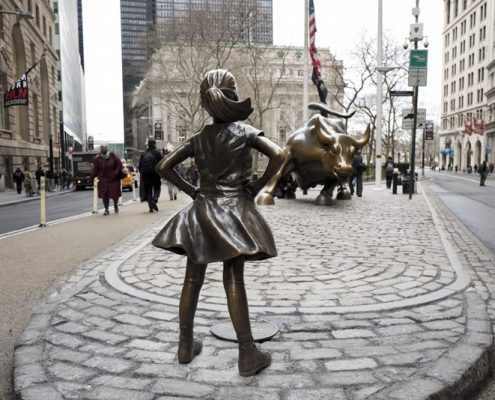How a little girl on Wall Street brought attention to a global issue
How a little girl on Wall Street brought attention to a global issue

Starting this month, the team at Bristol would like to welcome you to Bristol Insights, a monthly feature where we discuss, analyse and highlight topics of interest across the field of investor relations that are relevant to management and the investment community. The objective is to provide a perspective on current topics that are relevant in today’s fast changing, global and multi- faceted business environment. We hope you enjoy reading and we would love to hear from you if you have thoughts and comments on specific features and content.
Our first feature is a large macro topical one, and one that garners much debate amongst the general business community at large. The team at Bristol feels it warranted the inaugural feature of the series, considering the observation of International Women’s Day last week and the unveiling of The Fearless Girl on Wall Street.
International Women’s Day was celebrated around the world last week on March 8th. For some countries its just another day, while for some 15 other countries it is a national holiday, including countries such as Russia, the Ukraine and Vietnam. While International Women’s Day is now largely aimed at inspiring women across the world and celebrating their achievements, its roots are in movements campaigning for better pay and voting rights. The first National Women’s Day was marked on 28th February 1909 in the United States after a declaration by the Socialist Party of America. Clara Zetkin, leader of the Women’s Office for the Social Democratic Party in Germany proposed the idea for an International Women’s Day, which was met with unanimous approval. The day has grown in size and importance globally and this year it had its own hashtag of #beboldforchange.
This year, ahead of International Women’s Day, the Boston-based State Street corporation installed The Fearless Girl statue in the heart of New York City’s financial district. The work by artist Kristen Visbal drew hundreds of tourists and workers to pose for photos on Wednesday and the following days. With her head held high and her hands firmly on her waist, the small girl appears to be staring down at the iconic Charging Bull.
With this bold statement, State Street wanted to make the point that there is a lack of women on the boards of the largest US corporations. “As a steward of nearly $2.5 trillion of assets, we want to engage with boards and management around issues that we think will drive core results,” said Lori Heinel, State Street’s deputy global chief investment officer. “And what you find repeatedly is having more diverse boards and more diverse senior management will actually drive better results for companies.” 25 percent of the Russell 3000, an index of the nation’s largest companies, have no women on their boards, according to State Street, who manage many of their assets. Nearly 60 percent have fewer than 15 percent female directors.
“We really wanted the bull to have a partner, and a partner that we thought was worthy of him,” Heinel said. “And so we got a very determined young woman who is fearless and is willing to drive the change that we believe we need.” The plaque at her feet says: “Know the power of women in leadership. SHE makes a difference.” (SHE is what State Street have called their efforts to advance women to leadership roles.)
The money manager said it would vote against boards if a company failed to take steps to increase its number of members who are women. State Street planned to send a letter to 3,500 companies on March 7th, asking the companies to act. State Street is one of the biggest players in the index fund world, managing about 90 percent of its assets in passive funds, which are often invested in companies held in the Russell 3000 and FTSE. The money manager has cited gender diversity as a way to improve company performance and increase shareholder value. “There has been a lot of discussion on this topic, but the needle hasn’t moved materially. State Street wants every company it’s targeting to have at least one female board member and to take steps toward fixing its gender gap. We are not going to automatically vote against the company, but we want to make sure there are tangible, concrete measures being taken,” Heinel said.
In the business world and boardroom where women are still unrepresented, this kind of bold statement says a lot. Who knows if in the years to come the equilibrium will be more balanced or not, but with large organizations starting the conversation and taking a stand with various stakeholders and partners, the hope is that positive change will begin to be seen sooner rather than later. Change for real change and not change merely for quotas.
Sources:
Associated Press
Business Insider
The Daily Mirror
